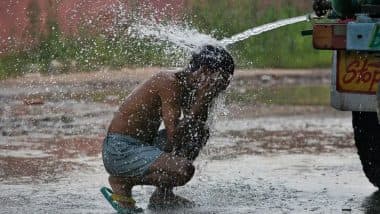New Delhi, April 9: At least 26 weather stations recorded maximum temperatures equal to or above 43 degrees Celsius in Gujarat, Rajasthan, Maharashtra and Madhya Pradesh amid persisting heatwave conditions on Wednesday, the India Meteorological Department (IMD) said. Four weather stations in Delhi recorded heatwave conditions. Temperatures soared to a blistering 45.6 degrees Celsius in Gujarat's Kandla, the highest in the country for the day.
ajkot recorded 45.2 degrees Celsius, Amreli 44.3 degrees Celsius and Surendranagar 43.8 degrees Celsius. Porbandar, a coastal city, reported an unusually-high 43 degrees Celsius, 8.8 notches above normal. Deesa and Ahmedabad also recorded temperatures above 43 degrees Celsius. In Rajasthan, Pilani recorded 44.9 degrees Celsius, Phalodi and Churu touched 43.8 degrees Celsius and 43.5 degrees Celsius respectively, while Bikaner and Jaipur registered 43.4 degrees Celsius and 43 degrees Celsius. Delhi Weather Forecast: City Records Season슬롯사이트™s First Heatwave, IMD Extends Yellow Alert for Next 2 Days.
Many of these places reported temperature departures of six to eight degrees above normal. In Maharashtra, Akola and Jalgaon both reported a maximum temperature of 43.7 degrees Celsius, while Malegaon recorded 43.2 degrees Celsius. Central India was not spared either. Ratlam in Madhya Pradesh recorded 44.2 degrees Celsius, 6.3 notches above normal, while Hoshangabad touched 43.2 degrees Celsius.
The weather department said the ongoing heatwave in northwest India is likely to ease from April 10 under the influence of a Western Disturbance and in Gujarat and Madhya Pradesh, from April 11. IMD scientist and spokesperson Naresh Kumar warned of a fresh heatwave spell from April 14-15 in Punjab, Haryana and Rajasthan. The IMD declares a heatwave when the maximum temperature is at least 40 degrees Celsius in the plains, 37 degrees Celsius in coastal areas and 30 degrees Celsius in hilly regions, and the temperature is 4.5 to 6.4 degrees Celsius above normal. A severe heatwave is declared if the departure is 6.5 degrees Celsius or more.
A heatwave is also declared if the actual maximum temperature touches 45 degrees Celsius and a severe heatwave if it reaches 47 degrees Celsius, regardless of the departure from normal. Earlier this month, the weather department said the country is likely to experience above-normal temperatures from April to June, with more heatwave days in central and eastern India and the northwestern plains. Weather Forecast Today, April 07: Check Weather Updates, Rain Predictions for Mumbai, Delhi, Chennai, Bengaluru, Hyderabad, Shimla and Kolkata.
Some states, including eastern Uttar Pradesh, Jharkhand, Chhattisgarh and Odisha, are expected to have 10 to 11 heatwave days during this period. The year 2024 was the warmest recorded both in India and globally. This year, heatwave conditions were observed as early as February 27-28. The first official heatwave of 2024 was recorded on April 5. Official data showed that India recorded nearly 42,000 suspected heat-stroke cases and 143 heat-related deaths last year during one of its hottest and longest heatwaves.
Public health experts say the official number of heat-related deaths is an undercount as 20 to 30 per cent of heat-stroke cases usually result in fatalities. While heatwaves are common in April and May, scientists say climate change is making them more frequent and intense. This further burdens low-income households, which often have poor access to water and cooling, and tests the endurance of outdoor workers toiling in the searing sun, forcing them to take frequent breaks.
The experts say outdoor workers, the elderly and children are at higher risk of heat exhaustion and heatstroke. According to the World Health Organization (WHO), more than 1.66 lakh people died as a result of heatwaves between 1998 and 2017. India reported 3,812 deaths due to heatwaves between 2015 and 2022, with Andhra Pradesh alone logging 2,419 fatalities. A 2022 study warned that the risk of heatwaves could increase 10-fold in the 21st century, with more than 70 per cent of India's land area likely to face extreme heat.













 Quickly
Quickly

















